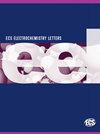A Critical Assessment of as a Figure of Merit for Oxygen Reduction Electrocatalysts in Aqueous Electrolytes
引用次数: 9
Abstract
Certain aspects of the interpretation of rotating ring-disk electrode, RRDE, data for the oxygen reduction reaction, ORR, in aqueous electrolytes have been examined. In particular, the classical mechanism proposed by Damjanovic et al. [J. Chem. Phys. 45, 4057 (1966)] predicts that at a fixed potential, a plot of the ratio of the disk to the ring currents for the ORR vs ω−1/2, where ω is the rotation rate of the disk, should be linear. According to this analysis, the slope of this line is proportional to k3/XH2O2 , where k3 is the rate constant for the reduction of solution phase hydrogen peroxide, H2O2(aq), and XH2O2 is the fraction of the disk current that generates H2O2(aq), the magnitude of which can be determined from the line intercept. Illustrations of this theoretical framework are provided for ORR data reported in the literature for experiments involving Pt-based electrodes and collected in our laboratories for Pt in aqueous acidic solutions. Critically emphasized is the need to perform ring-disk measurements at multiple rotations rates in order to determine reliable values of XH2O2 , which can be used as figures of merit for ranking the efficacy of ORR electrocatalysts. © The Author(s) 2015. Published by ECS. This is an open access article distributed under the terms of the Creative Commons Attribution 4.0 License (CC BY, http://creativecommons.org/licenses/by/4.0/), which permits unrestricted reuse of the work in any medium, provided the original work is properly cited. [DOI: 10.1149/2.0021506eel] All rights reserved.水电解质中氧还原电催化剂性能指标的关键评价
对旋转环盘电极的某些方面的解释,RRDE,氧还原反应的数据,ORR,在水电解质中进行了检查。特别是Damjanovic等人提出的经典机制[J]。化学。物理学[Phys. 45,4057](1966)预测,在一个固定的电位下,圆盘与环电流的比值对于ORR vs ω−1/2的图,其中ω是圆盘的旋转速率,应该是线性的。根据这个分析,这条线的斜率与k3/XH2O2成正比,其中k3是液相过氧化氢H2O2的还原速率常数(aq), XH2O2是产生H2O2的磁碟电流的分数(aq),其大小可以从线截距确定。这一理论框架的插图提供了文献中涉及Pt基电极的实验报告的ORR数据,并在我们的实验室中收集了酸性水溶液中的Pt。需要强调的是,需要在多个旋转速率下进行环盘测量,以确定可靠的XH2O2值,该值可作为评价ORR电催化剂效率的指标。©作者2015。由ECS出版。这是一篇基于知识共享署名4.0许可(CC BY, http://creativecommons.org/licenses/by/4.0/)的开放获取文章,该许可允许在任何媒体上不受限制地重复使用该作品,前提是正确引用原始作品。[DOI: 10.1149/2.0021506]版权所有。
本文章由计算机程序翻译,如有差异,请以英文原文为准。
求助全文
约1分钟内获得全文
求助全文
来源期刊

ECS Electrochemistry Letters
ELECTROCHEMISTRY-MATERIALS SCIENCE, MULTIDISCIPLINARY
自引率
0.00%
发文量
0
 求助内容:
求助内容: 应助结果提醒方式:
应助结果提醒方式:


